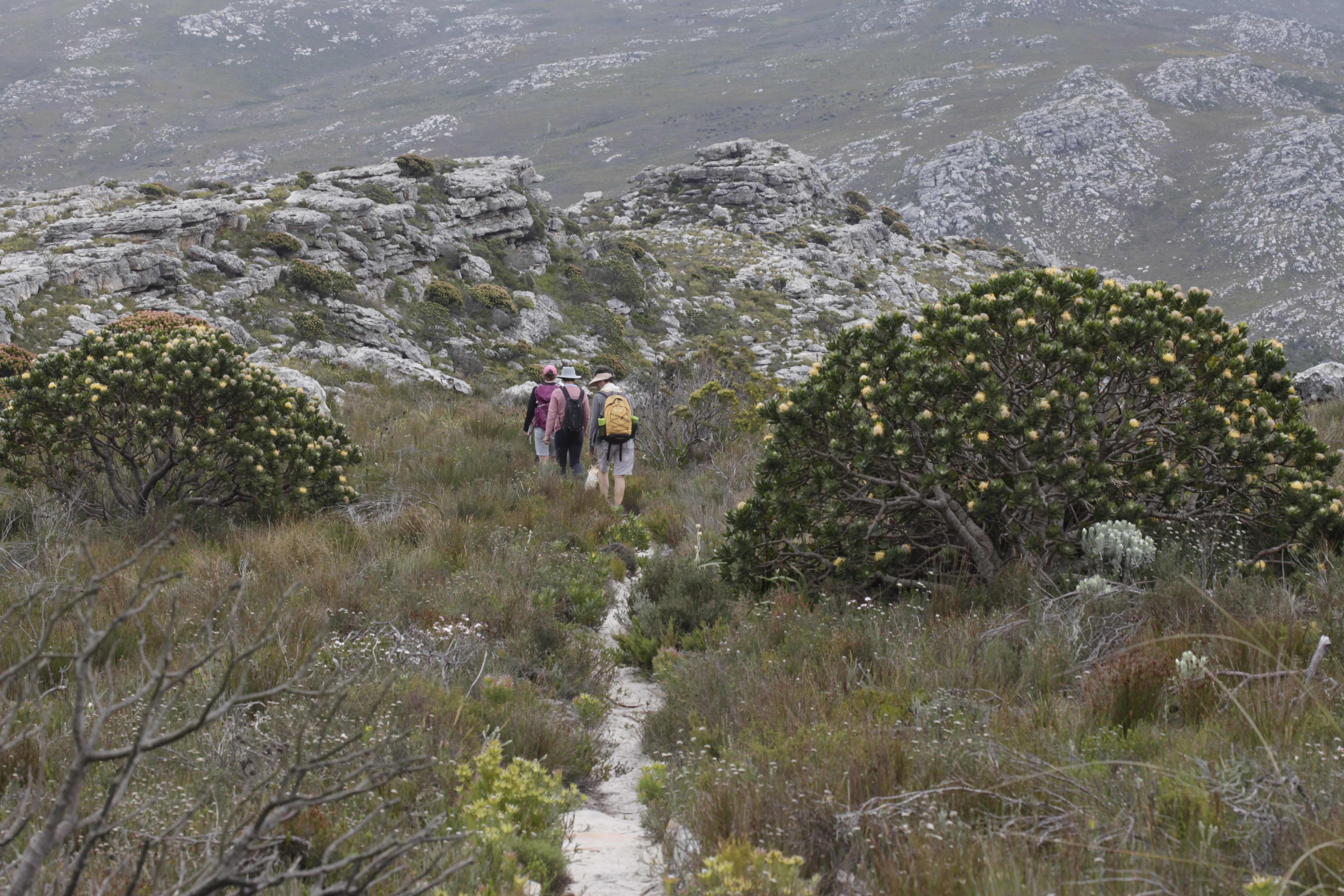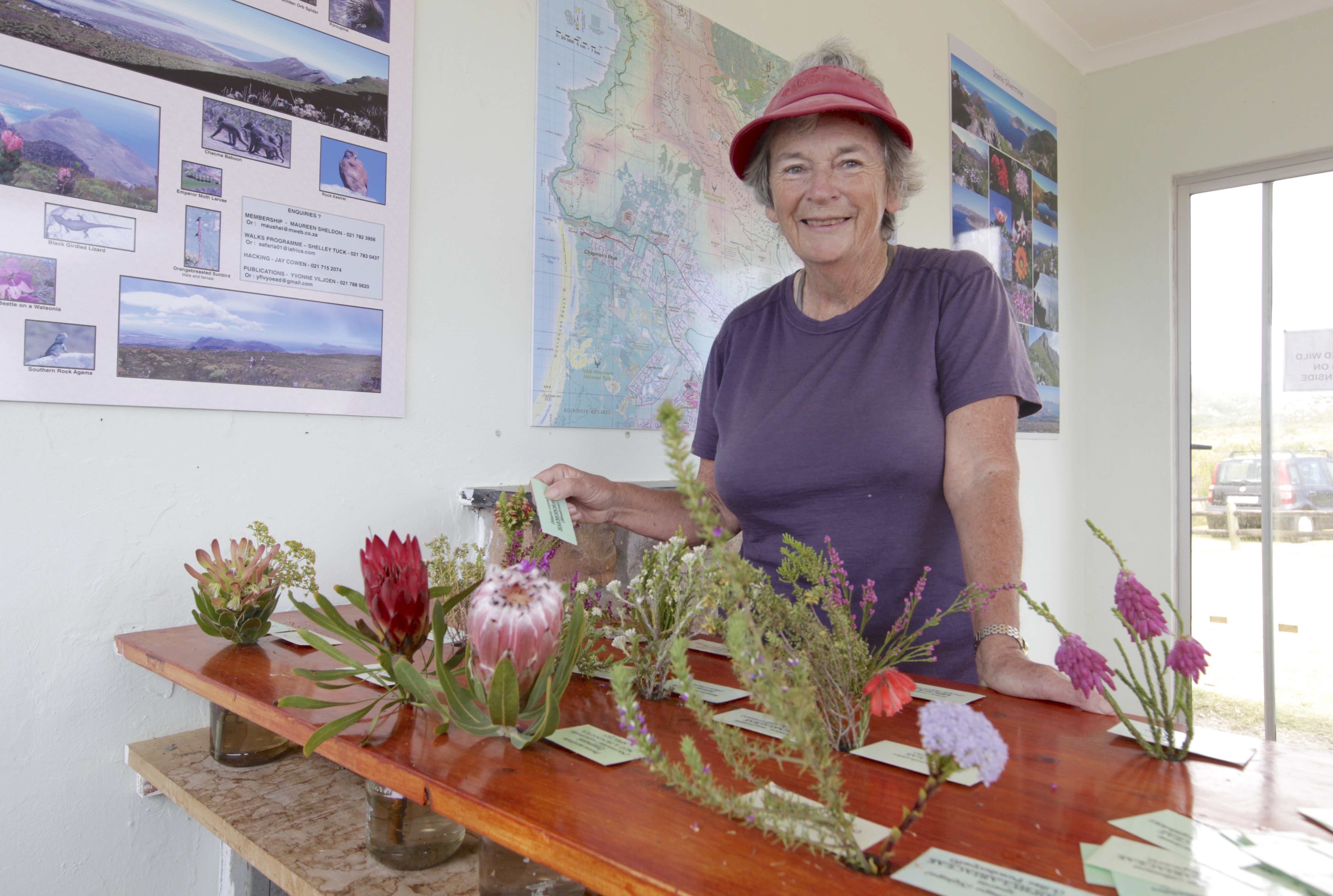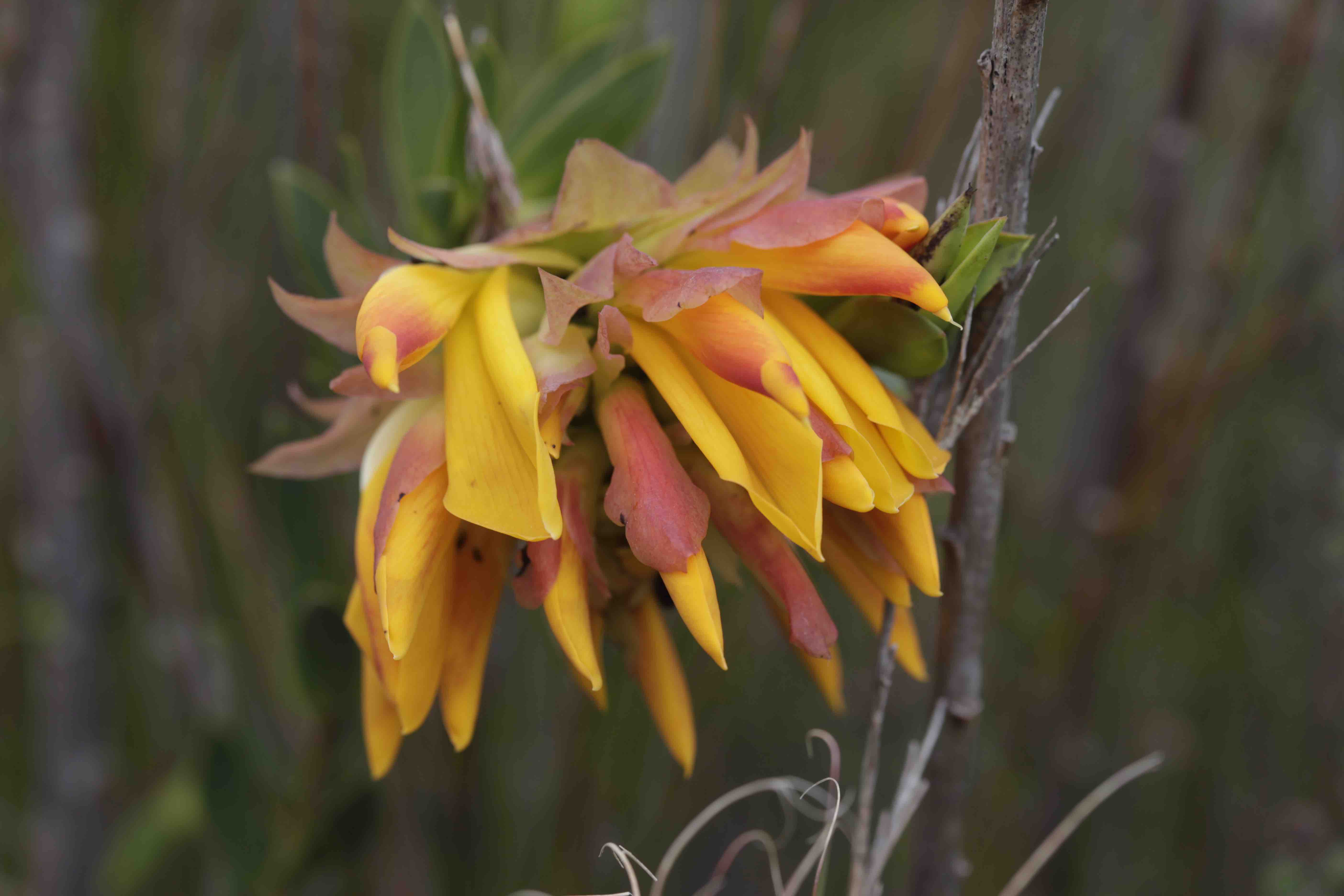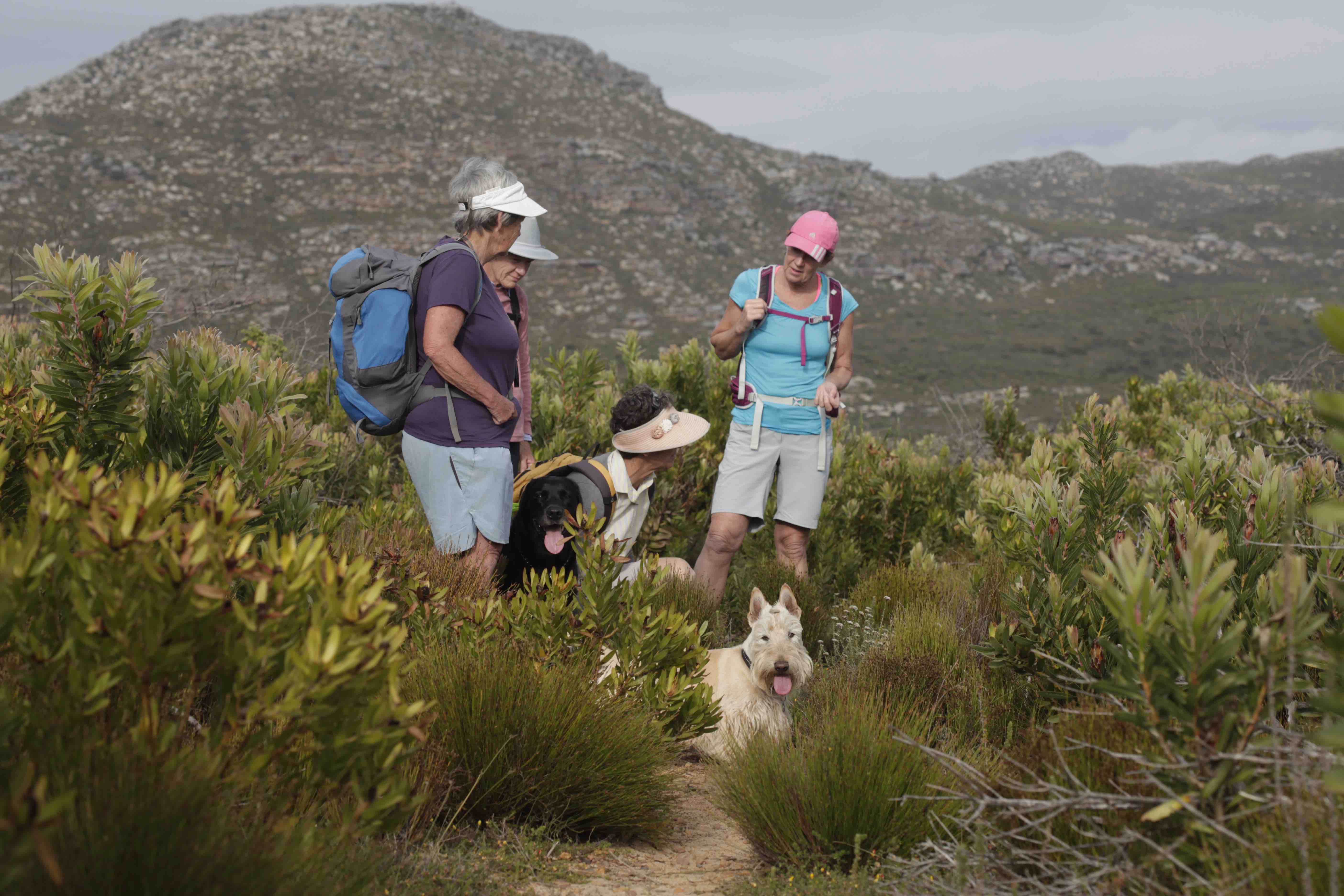Fiona McIntosh goes hiking in the Silvermine section of Table Mountain National Park, one of the hotspots of the Cape Floral Kingdom World Heritage Site
“Now this is an interesting one,” says Corinne Merry. I reach for my flower book and try to identify the little pink flower. Four petals, yellow centre, long, slightly hairy leaves. But there’s nothing in the book to match. “It’s Struthiola ciliata but with the four inner yellow petals missing; an aberration,” Corinne advises. “Struth, but it’s pretty.” She’s encouraging me to use association to remember flower names.
“Struth, it’s impossible,” I retort. “How’s a gal to learn the flowers if they don’t stick to the rules?”
Shaen and I are out walking with members of Friends of Silvermine Nature Area (FOSNA), Corinne, Caroline Voget and Shelley Tuck. One of most beautiful and diverse sections of Table Mountain National Park, Silvermine Nature Reserve is Mecca for hikers and other outdoor enthusiasts, particularly lovers of pretty flowers.
“Struth, it’s impossible,” I retort. “How’s a gal to learn the flowers if they don’t stick to the rules?”
Shaen and I are out walking with members of Friends of Silvermine Nature Area (FOSNA), Corinne, Caroline Voget and Shelley Tuck. One of most beautiful and diverse sections of Table Mountain National Park, Silvermine Nature Reserve is Mecca for hikers and other outdoor enthusiasts, particularly lovers of pretty flowers.
Key Considerations
- Up to it? With trails ranging from easy walks around the dam and along the river to strenuous climbs of Constantiaberg and other peaks, Silvermine has walks to suit hikers of all levels of experience and fitness.
- Gate times: Silvermine West: 07.00-19.00 in summer, 08.00-18.00 in winter
(May to August). Last entry is one hour before closing time. Silvermine East:
08.00-18.00. - Unless you have a Wild Card you’ll be charged a small fee to enter Silvermine
West. Entrance to Silvermine East is free. My Activity Permits are required for
dog walkers, mountain bikers, rock climbers and paragliders. - For more information visit www.tmnp.co.za or call 021 712 7471
From the car park at Gate 2 (Silvermine East) we walk up towards Higher Steenberg Peak, past big bushes of prickly, yellow Cape gorse (Aspalathus carnosa) that have blossomed since the fire of 2015. This part of the reserve is open access and very popular with dog walkers - with the appropriate permits. Corinne’s black Labrador and Caroline’s Scottie are on home turf.
The path skirts the steep rock bands of Wolfkop then ascends stone steps. We stop to inspect some delicate little pin spiderheads (Serruria fasciflora), their fine, silky leaves resembling spider webs and Microdon dubius, with its tiny (micro) flowers. I’m beginning to crack the code.
Corinne is an enthusiastic and patient teacher. An amateur botanist with a PhD in Theoretical Physics, she has thrown herself into photographing flowers since retiring from a later career in software development and now has a couple of books to her name.
“I grew up in Caledon and frequented the Wild Flower Garden there,” she tells us. “I always loved our indigenous flora and took the odd flower photo, but when I got my first digital camera in 2004 I went wild. The late Professor Deon Kesting had started documenting the flora of the Cape Peninsula in the early 1980s and I joined FDP in order to help them photograph the flowers.
The path skirts the steep rock bands of Wolfkop then ascends stone steps. We stop to inspect some delicate little pin spiderheads (Serruria fasciflora), their fine, silky leaves resembling spider webs and Microdon dubius, with its tiny (micro) flowers. I’m beginning to crack the code.
Corinne is an enthusiastic and patient teacher. An amateur botanist with a PhD in Theoretical Physics, she has thrown herself into photographing flowers since retiring from a later career in software development and now has a couple of books to her name.
“I grew up in Caledon and frequented the Wild Flower Garden there,” she tells us. “I always loved our indigenous flora and took the odd flower photo, but when I got my first digital camera in 2004 I went wild. The late Professor Deon Kesting had started documenting the flora of the Cape Peninsula in the early 1980s and I joined FDP in order to help them photograph the flowers.

The path has levelled out now that we’re on the Steenberg Plateau, giving us breath to chat. Current Chairperson, Shelley Tuck joined FOSNA to meet like- minded people after relocating from Johannesburg. “I’m in awe of the hike leaders’ encyclopaedic knowledge of flowers,” she says.
“FOSNA enhances my well-being but we Friends also make a significant material contribution to the preservation of our natural heritage. We have an active hacking group that removes alien vegetation; our Riverine Rovers look after the lower Silvermine wetlands area between Clovelly and Fish Hoek and we contribute to various projects such as the repair of fire-damaged boardwalks and water tanks, tree planting and a camera for monitoring the activities of animals. The passionate FDP group have so far photographed and documented 1601 species of the 2355 species found on the Cape Peninsula and sales of the database that showcases these (on DVD or the FloraDoc app) help fund FOSNA’s projects.
As we walk my learned friends point out the most conspicuous flowers, the conebushes, sugarbushes, daisies and Mimetes - the families of which I’m familiar with, if not the species – and find some treasures like the rare bloodroot (Dilatris corymbosa).
“FOSNA enhances my well-being but we Friends also make a significant material contribution to the preservation of our natural heritage. We have an active hacking group that removes alien vegetation; our Riverine Rovers look after the lower Silvermine wetlands area between Clovelly and Fish Hoek and we contribute to various projects such as the repair of fire-damaged boardwalks and water tanks, tree planting and a camera for monitoring the activities of animals. The passionate FDP group have so far photographed and documented 1601 species of the 2355 species found on the Cape Peninsula and sales of the database that showcases these (on DVD or the FloraDoc app) help fund FOSNA’s projects.
As we walk my learned friends point out the most conspicuous flowers, the conebushes, sugarbushes, daisies and Mimetes - the families of which I’m familiar with, if not the species – and find some treasures like the rare bloodroot (Dilatris corymbosa).

“In order to identify a plant you need to study both the flower and the leaves,” Corinne insists using the serrated leaves of the purple powderpuff (Pseudoselago serrata) by way of example, as the flowers are very similar to those of Pseudoselago spuria, while the leaves are very different. Buoyed at recognising a mountain dahlia (Liparia splendens) and graceful painted lady (Gladiolus debilis) I confidently suggest that a striking purple-pink flower is pea family. “On first impression it looks like a pea,” Caroline agrees gently. “But it’s actually Polygala. If you look closely you’ll see that there’s no keel or pod.”
Quiet but knowledgeable, the long time member of FDP was formerly editor of the Botanical Society’s magazine Veld & Flora. “I was always interested in wildlife and nature, and had some experience of publishing, so when the editor of Veld & Flora resigned in the 1980s I agreed to fill in until they found a ‘proper’ botanist,” she recalls. “Twenty three years later I was still there.”
The slopes are a blaze of pink and purple Ericas, the most taxing of all. Having admired the tiny flowers of the widespread, wonderfully named hairy-flower heath (Erica hirtiflora), I confuse it a few minutes later with the very similar looking (to me at least) beauty heath (Erica pulchella). Then I’m flummoxed by a beautiful, low-growing flower that, again, I can’t find in my flower book. “Ah ha”, laughs Corinne, “this is an interesting plant. It’s the smallest protea, Diastella divaricata – sometimes known as the Peninsula silky puff (like most botanists, Corinne insists on using the scientific, not common names) - but the leaves are unsually red. It might be that the plant is stressed, possibly through not getting enough rain.”
Quiet but knowledgeable, the long time member of FDP was formerly editor of the Botanical Society’s magazine Veld & Flora. “I was always interested in wildlife and nature, and had some experience of publishing, so when the editor of Veld & Flora resigned in the 1980s I agreed to fill in until they found a ‘proper’ botanist,” she recalls. “Twenty three years later I was still there.”
The slopes are a blaze of pink and purple Ericas, the most taxing of all. Having admired the tiny flowers of the widespread, wonderfully named hairy-flower heath (Erica hirtiflora), I confuse it a few minutes later with the very similar looking (to me at least) beauty heath (Erica pulchella). Then I’m flummoxed by a beautiful, low-growing flower that, again, I can’t find in my flower book. “Ah ha”, laughs Corinne, “this is an interesting plant. It’s the smallest protea, Diastella divaricata – sometimes known as the Peninsula silky puff (like most botanists, Corinne insists on using the scientific, not common names) - but the leaves are unsually red. It might be that the plant is stressed, possibly through not getting enough rain.”

And so it goes on.
Shelley sympathises, she tries to learn one flower a week but doesn’t find it easy. This week she’s cracked a Silvermine special, the sticky green heath (Erica urna- viridis).
We stop at the Fat Lady's Shelter for tea. This is the best part of any walk the Friends tell me as they produce flasks and homemade cookies. You sit down and just absorb your surroundings.
Refreshed we continue on up to through the increasingly rugged landscape to Higher Steenberg Peak where we scramble out on a rocky outcrop to inspect the rarely-seen green bladder heath (Erica halicacaba). Caroline locates a little leek orchid (Disa bracteata) that I’ve never seen before. It’s a wonderful voyage of discovery.
Our circular route takes us around Splitkop, along the Firebreak Path and then back down to the cars through impressive stands of conebushes and pincushions that were clearly protected from the worst of the fire. I recognise Kreupelhout or the Grey Tree Pincushion, (Leucospermum conocarpodendron), from my regular hikes on the Camps Bay side of the mountain, before discovering that this south peninsula version is actually a sub-species, Leucospermum conocarpodendron subsp viridum which has greenish rather than grey leaves. Aargh.
The manned entrance gate, ranger patrols and tourism monitors (drawn from the surrounding communities and funded by the Department of Tourism) ensure that Silvermine West is much safer and easier to manage than the open access areas of Table Mountain National Park. But SANParks Section Ranger Slindile Sosibo is grateful for the efforts of the FOSNA volunteers. “We issue permits to FOSNA to clear aliens and collect flowers for the info kiosk, and since their members walk the trails regularly they are extra eyes and ears, feeding back on maintenance and other issues that we need to attend to, and raising the necessary funding.” Car guard Henry Josephs greets us when we pull in to the packed car park near the dam. Formerly a field ranger he knows the reserve like the back of his hand and is always keen to advise on birdcalls and what’s in bloom. “The March lilies (Amaryllis belladonna) are flowering by the dam wall at the moment,” he tells us, “and there are lots of cluster disas (Disa ferruginea) and blue disas (Disa graminifolia) on the Amphitheatre Path if you fancy a longer walk.”
Shelley sympathises, she tries to learn one flower a week but doesn’t find it easy. This week she’s cracked a Silvermine special, the sticky green heath (Erica urna- viridis).
We stop at the Fat Lady's Shelter for tea. This is the best part of any walk the Friends tell me as they produce flasks and homemade cookies. You sit down and just absorb your surroundings.
Refreshed we continue on up to through the increasingly rugged landscape to Higher Steenberg Peak where we scramble out on a rocky outcrop to inspect the rarely-seen green bladder heath (Erica halicacaba). Caroline locates a little leek orchid (Disa bracteata) that I’ve never seen before. It’s a wonderful voyage of discovery.
Our circular route takes us around Splitkop, along the Firebreak Path and then back down to the cars through impressive stands of conebushes and pincushions that were clearly protected from the worst of the fire. I recognise Kreupelhout or the Grey Tree Pincushion, (Leucospermum conocarpodendron), from my regular hikes on the Camps Bay side of the mountain, before discovering that this south peninsula version is actually a sub-species, Leucospermum conocarpodendron subsp viridum which has greenish rather than grey leaves. Aargh.
Among FOSNA’s aims are helping SANParks beautify the reserve, so after our walk we drive across the road to the replace the flowers in the little information kiosk at Silvermine West. Zandile Mtati welcomes us as she checks our Wild Cards and we bump into Pete du Preez, a volunteer ranger and Chairman of the Table Mountain National Park Paragliding Working Group. He’s on his way to fly from the reserve’s highest peak. We regulars feel like part of a big family.
The manned entrance gate, ranger patrols and tourism monitors (drawn from the surrounding communities and funded by the Department of Tourism) ensure that Silvermine West is much safer and easier to manage than the open access areas of Table Mountain National Park. But SANParks Section Ranger Slindile Sosibo is grateful for the efforts of the FOSNA volunteers. “We issue permits to FOSNA to clear aliens and collect flowers for the info kiosk, and since their members walk the trails regularly they are extra eyes and ears, feeding back on maintenance and other issues that we need to attend to, and raising the necessary funding.” Car guard Henry Josephs greets us when we pull in to the packed car park near the dam. Formerly a field ranger he knows the reserve like the back of his hand and is always keen to advise on birdcalls and what’s in bloom. “The March lilies (Amaryllis belladonna) are flowering by the dam wall at the moment,” he tells us, “and there are lots of cluster disas (Disa ferruginea) and blue disas (Disa graminifolia) on the Amphitheatre Path if you fancy a longer walk.”

“Henry often shows me special flowers and unusual stuff,” says Corinne. “He once spotted a baby porcupine under a car; another time he found a genet curled up in the dog poo bin.”
It’s a sunny day and the boardwalks, beaches and braai sites around the dam are buzzing. There are swimmers in wetsuits doing laps, kids floating on lilos and big groups picnicking on the rocks. But it’s the only place that’s ever crowded: most of the reserve is mountain wilderness.
“Silvermine is my ‘go to’ place when I need to relax,” says Slindile. “I escape the office and just come and sit on a rock or take a short hike to calm me down. I love the fact that there are so many different recreational users here; walkers, families chilling, mountain bikers, trail runners, rock climbers setting out for the crags and paragliders for the peaks. Silvermine caters for everyone, fit or unfit.”
Inspired by my botanical walk and the real sense of a community working together I’m in no hurry to leave so head up towards Noordhoek Peak where the paragliders are preparing to launch. Sitting on its summit I take in the 360- degree view of Table Mountain, the Atlantic Ocean, Cape of Good Hope Reserve and the beaches and harbours of False Bay. I feel on top of the world. This picturesque reserve is one of the country’s gems.
Images by Shaen Adey and Corinne Merry
It’s a sunny day and the boardwalks, beaches and braai sites around the dam are buzzing. There are swimmers in wetsuits doing laps, kids floating on lilos and big groups picnicking on the rocks. But it’s the only place that’s ever crowded: most of the reserve is mountain wilderness.
“Silvermine is my ‘go to’ place when I need to relax,” says Slindile. “I escape the office and just come and sit on a rock or take a short hike to calm me down. I love the fact that there are so many different recreational users here; walkers, families chilling, mountain bikers, trail runners, rock climbers setting out for the crags and paragliders for the peaks. Silvermine caters for everyone, fit or unfit.”
Inspired by my botanical walk and the real sense of a community working together I’m in no hurry to leave so head up towards Noordhoek Peak where the paragliders are preparing to launch. Sitting on its summit I take in the 360- degree view of Table Mountain, the Atlantic Ocean, Cape of Good Hope Reserve and the beaches and harbours of False Bay. I feel on top of the world. This picturesque reserve is one of the country’s gems.
Images by Shaen Adey and Corinne Merry
Shop for a cause
Conservation Mag is an Amazon affiliate, by clicking on the links to do your shopping you support us without paying anything extra.
Shop on amazon.com | amazon.co.uk
Shop on amazon.com | amazon.co.uk


